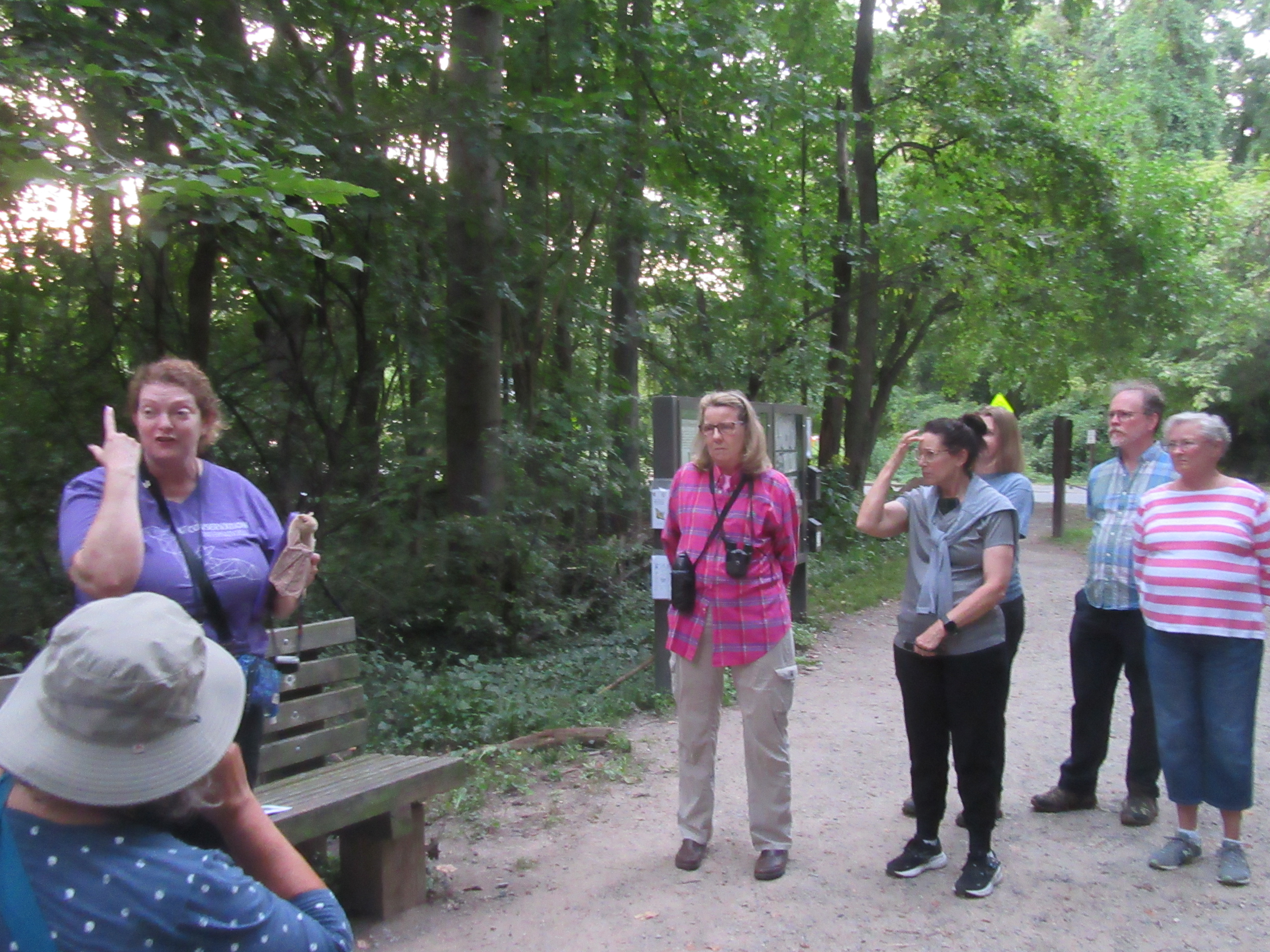Derogatory expressions like “dingbat,” “going batty” and “blind as a bat” seem ingrained in the American lexicon. For starters, bats are not blind, but many bat myths abound.
Bats are valuable wildlife with “excellent eyesight,” Deborah Hammer told the 21 people who attended a bat walk in Dyke Marsh on a balmy Aug. 25 night. Hammer is a board member of both the Friends of Dyke Marsh and Bat Conservation and Rescue of Virginia.
As dusk fell, these nocturnal aerialists zipped about above the trail, a bat silhouette seeming to streak by above every 30 seconds or so. “They are waking up and coming out,” she said.
Observers have documented over 1,400 bat species in the world, seventeen in Virginia and at least seven in Dyke Marsh.
 The group of 21 people who attended a bat walk in Dyke Marsh on Aug. 25 had a tutorial on bats.
The group of 21 people who attended a bat walk in Dyke Marsh on Aug. 25 had a tutorial on bats.
Bats Are Beneficial
Many bats eat insects like mosquitoes, beetles, moths and flies. They can “consume their body weight in insects in one night, perhaps up to 1,000 insects,” Hammer said.
“All bats in the mid-Atlantic are insect eaters,” notes the Audubon Field Guide to the Mid-Atlantic.
In some parts of the world, bats disperse seeds. Worldwide, around 80 percent of fruits are pollinated by bats, fruits like papaya, guava and mango. Bats have a role in fertilizing and disseminating seeds of trees, including breadfruit, plantain, fig, clove, banana and peach, says the Virginia Department of Wildlife Resources (DWR) website.
Bats are mammals, meaning their young are born alive and mothers feed their young milk. They are the only mammal that can fly. (Flying squirrels do not fly; they glide.) A bat’s wing is a membrane stretched across the slim bones of its forearms and fingers. Most bats in Northern Virginia have a mouse-like body. During the day, they roost in a secluded spot by hanging upside down.
Bats navigate to find food using what’s called echolocation. “By emitting a high frequency pulse that travels out and bounces off an object and then returns to the bat, they are able to determine distance, size and direction of the object,” says DWR. Usually, the echolocation sounds are at a high frequency, inaudible to humans. They also emit high-pitched twittering sounds which Hammer shared by using a sonar detector.
By mid-October in the Washington region, insects are gone most bats move south or hibernate until spring. Tree bats hibernate in tree cavities, like woodpecker holes; cave bats, in caves. In Northern Virginia, they might hibernate in tree holes, woodpiles or rock crevices. Hoary bats can curl up and camouflage like a pinecone. Red bats hanging by their feet can resemble a leaf, Hammer said.
In sum, bats help maintain balance in nature, say experts.
Threats and Conservation
At least 52 percent of bat species in North America are “at risk of populations declining severely in the next 15 years” and need conservation action, according to the U.S. Fish and Wildlife Service (FWS).
Hammer lamented that a fungus called “white-nose syndrome” is killing bats. This white fungus appears on the muzzles or noses of infected bats, Hammer explained. “It has a 90 percent mortality rate,” she said.
Other threats include wind turbines, climate change, habitat loss, roost disturbances and disease.
Mount Vernonite Clarence Monteiro attended the bat walk and commented, “Bats have huge benefits to farmers by keeping mosquitoes and other insects in check. I wanted to learn more about our native bats. Hearing that their numbers are greatly diminished due to white nose syndrome was concerning.”
Some scientists are trying to protect bats’ hibernating and maternity sites. Some people install bat houses to provide habitat and cover. For guidance, see https://dwr.virginia.gov/wildlife/bats/bat-houses/.
As bat fans scanned the darkening sky, a likely predator, a barred owl, called nearby.
“There is still much to be learned about the biology of bats in Virginia and around the world,” says DWR.
Resources & Information
Conservation Status and Threats to North American Bats, 2023, https://batconservationalliance.org/
Virginia bats, https://dwr.virginia.gov/wildlife/bats/
Bat Conservation and Rescue of Virginia, https://www.virginiabats.org/
